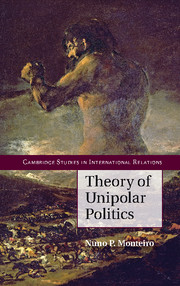Book contents
- Frontmatter
- Dedication
- Epigraph
- Contents
- Acknowledgments
- 1 Introduction
- 2 Conceptualizing Unipolarity
- 3 The Scope of Unipolar Strategic Choice
- 4 The Sources of Competition under Unipolarity
- 5 Competition in the Post–Cold War Era
- 6 The Sources of Conflict under Unipolarity
- 7 Conflict in the Post–Cold War Era
- 8 Conclusion
- Bibliography
- Index
5 - Competition in the Post–Cold War Era
Published online by Cambridge University Press: 05 June 2014
- Frontmatter
- Dedication
- Epigraph
- Contents
- Acknowledgments
- 1 Introduction
- 2 Conceptualizing Unipolarity
- 3 The Scope of Unipolar Strategic Choice
- 4 The Sources of Competition under Unipolarity
- 5 Competition in the Post–Cold War Era
- 6 The Sources of Conflict under Unipolarity
- 7 Conflict in the Post–Cold War Era
- 8 Conclusion
- Bibliography
- Index
Summary
The theory I laid out in the previous chapter yields two central empirical implications for contemporary world politics. First, for as long as the United States pursues a grand strategy of defensive accommodation, major powers, all of which today possess survivable nuclear arsenals, are unlikely to pursue further balancing against it. Second, in the event that the United States does shift toward any other strategy, major powers in the region in which U.S. strategy has shifted are likely to initiate a balancing effort – increasing the rate at which they convert their latent power into military capabilities, pooling those capabilities together through the formation of alliances, and eventually shifting the systemic balance of power and putting an end to unipolarity.
Regarding today's major powers – which include all nuclear states – most of the literature focuses on the potential for rapidly growing economic powers, such as China, to launch a military challenge to U.S. power preponderance. Therefore, although I touch briefly on the prospects that other potential U.S. challengers will emerge, my analysis focuses on the past trajectory and likely future behavior of China.
- Type
- Chapter
- Information
- Theory of Unipolar Politics , pp. 113 - 143Publisher: Cambridge University PressPrint publication year: 2014



